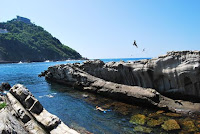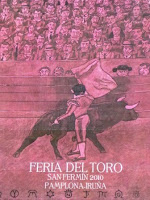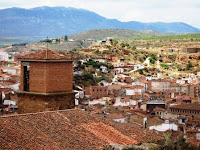The past few days we have been lucky enough to have some goregous weather. Because the weather can change drastically in a matter of hours, when it's nice, you have to take advantage of it and that's what I have been doing.
Last Thursday we decided to ditch the beach and get a different ocean experience by going to the island that sits in the shell-shaped inlet of the Concha beach. About 12 acres big, I had been to the island (named Santa Clara) only once before - and arrived with only a swimsuit because someh
ow I managed to swim all the way there! This time we took the boat that departs from the port every 30 minutes. I arrived quite early (thanks fast bike) and had some time to poke around and check out the colorful boats that dot the port while I waited
. Once on the boat it only took about 5 minutes to arrive and then I started the steep hike up the hill towards the only building on the island - a lighthouse. In the
gardens surrounding the uninhabitated lighthouse are lots of picnic tables
and knowing this in advance, we came prepared with tons of food - salads, sandwiches, cookies, etc.
After a quick rest for our full tummies we hiked down again towards the water. The island only has a small beach (that you can actually only see when it is low-tide) but since it is an is
After a quick rest for our full tummies we hiked down again towards the water. The island only has a small beach (that you can actually only see when it is low-tide) but since it is an is
land, there are many secret spots that you can enjoy the salty water. We found a spot with no grass but steep rocks that jut out of the island and plunge into the water and decided that it looked like a good spot to set up shop. My friend, Itziar (pronounced its-ee-are) and I thought that this spot looked like the perfect area for...drumroll please...snorkeling. Itziar really likes snorkeling
and scuba-diving, but I don't have much experience with either.
I did go scuba-diving once in Hawaii bu
t got so seasick that I basically puked on the boat the entire time, which attracted more fish and made my fellow scuba-divers excited about my poor stomach. This time, no scuba was involved - just some goggles with a
tube so that we could swim and gaze down at the sea-life below. With wetsuits and flippers we were off, exploring the water. After a few seconds of being kind of scared of breathing underwater (come on! it just doesn't feel natural!) I got the hang of it and was swimming near schools of fish, touching purple sea urchins (carefully of course, as to not get poked), holding orangey-pink starfish and letting it walk across my hand and admiring the bottom of the sea.



After feeling like a mermaid for long enough, we perched ourselves on t

he vertical jaggy rocks, making sure to avoid the quick-moving crabs and sharp l
impets (the shell-looking things that stick to rocks). From there, we could gaze out at the cloudless sky and soak in the sun, and that's exactly wha
t we did for a few hours. By 7:30pm we headed back to the
dock to catch the last boat at 8:00pm. Because I had swam here before I was quite thankful for this handy boat and couldn't help but think how bad it would have been if we had missed the last trip back. I mean, I like islands but I imagine if you had to stay there you would get quite the island fever. It was only later that I found out that at the end of the 16th century, when the plague hit San Sebastián, the people infected with the plague were sent, more like banished, to the island. And now, people PAY to go! Fathom that.
In other coastal activities, Laura and I decided to
continue our outdoor life with a hike to San Pedro (if you remember...Miles
and I took our bikeride here the other day). I just found out it was 7.6 kilometers (which is like 4.5 miles). YIKES! Anyways, after what seemed like a milli
on steps, although it was probably only 100, we reached the top of the hill and started the hike with some gorgeous views of Donostia. We walked along the mountain up and down, up and down, and up and down for what seemed like eternity and my legs were starting to get tired when finally a small little path appeared and led us down to the water. We agreed it was definitley time to stop for lunch (tuna fish sandwiches) and take a dip in the coo
l water. It wasn't exactly a beach, but instead a collection of huge rocks that we had to jump from one to another to get close to the water.
We took a small nap on the rocks and after about an hour of sleeping finished the hike by going down about 100 stairs. I was
quite happy we hadn't started on that end, because if I had to start a hike with 100 steps I wouldn't be the happiest camper in the bunch. Our tired feet were happy to rest on the busride back to San Sebastian and I was happy to have seen some other views of the Atlantic!
Besos!
Amanda



























